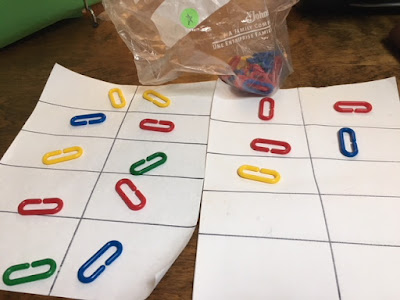Hi All,
The best way to learn to count well, is by counting lots of stuff. This is a simple activity kids love and they learn a great deal by the direct, real experience. It's called "Mystery Bags." In this activity, kids learn one to one correspondence, accurate counting, the idea of tens and ones and place value, and cooperative skills.
Preparation:
1. Take gallon plastic bags and fill them with the number of small items you want counted. Mark each bag with a different color dot for identification. You could also use a letter. Also in the bag include pre-cut tens frames. Each group should be given at least ten ten frames.2. Partner students up and give each student a response sheet to record their estimates and counts on,
3. Put the 12 pre-packed bags in a box. Invite partners to come up and choose a bag to begin with.
3a. Model emptying a bag (dont' say "dumping out" or that's what you will get, with pieces scattering across the floor) and then estimating and recording the estimate. Then show how you fill a ten frame, and then another, and keep going until you have a partially filled ten frame.
3b. Show students how to record the number of tens and number of ones and then the complete number. Model checking your count.
4. Students can work at desks, tables, or on the floor. Wherever there is enough room to spread out the items on the ten frames.
5. Tell students to "Write down the letter or color of your bag on your recording sheet. Estimate first and write the estimate down.
Open the bag and lay out the items on ten frames.
Count the tens. Count the ones. Write down the total.
Close up the bag. Return it to the box. Choose a new bag to count. Do as many bags as you can in a class period."
6. As you circulate notice how accurate student counts are. Observe how they are counting. Are they filling the ten frames and then counting by tens, or are they still counting by ones or maybe twos? Model again as needed.
7. Try to use a variety of items such as counting bears, counting chips, plastic animals, paper clips, bread bag tags, unifix cubes, digi-blocks, bottle caps, anything that fits in the ten frames squares. Mixed bags are also interesting for kids to work with.
This is a favorite math lab activity for counting and place value. Once the bags are made up and the ten frames copied, you can use them again and again.
Here are the links to the reproducibles (though I know the ones you would make yourself will be better!)
https://drive.google.com/file/d/1nrzskN2o3LVEIiljjoQja36ThVeRXjTB/view?usp=sharing
https://drive.google.com/file/d/1qLTeCqO8Vhs57AcGUZ_ShhjbUde12KSx/view?usp=sharing
Enjoy!
Bob



Comments
Post a Comment